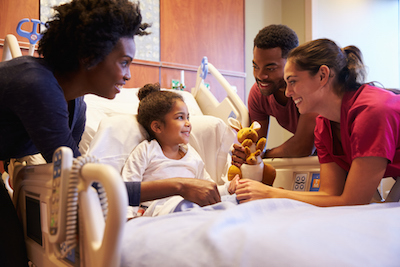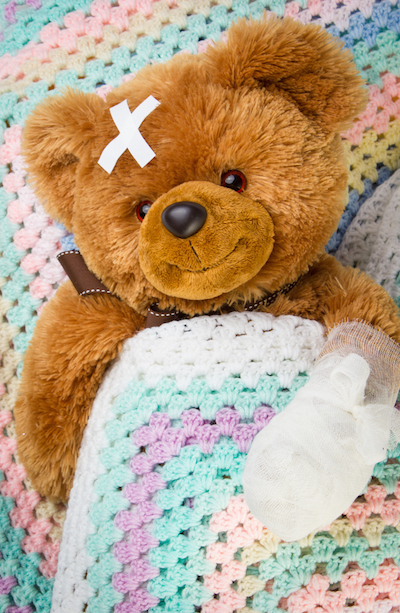Distraction can be a useful tool in helping your child cope with a difficult situation
As a Child Life Specialist, I often joke about the proverbial “toolkit” that I seem to have invisibly available when I work with children. In it are a variety of ideas, books, toys, and other items that I have used in the past that can benefit children as they go through painful procedures or times in the hospital that are particularly stressful. One of my best “tools” in this kit of mine is distraction.
Distraction as a positive coping strategy
 Distraction is exactly what it sounds like—utilizing age-appropriate items to provide an alternate focus for the patient. This may be helpful when a child has to undergo some type of procedure, is experiencing pain or is otherwise enduring a difficult or stressful event in their lives. For example, iPads are commonly used these days for children to watch movies or play some of their favorite games during procedures, but I also tend to favor good ol’ fashioned I Spy books, bubbles, distraction wands, and music, just to name a few. I often encourage families to bring items of comfort from home that can not only aid in distraction but in comforting the child as well.
Distraction is exactly what it sounds like—utilizing age-appropriate items to provide an alternate focus for the patient. This may be helpful when a child has to undergo some type of procedure, is experiencing pain or is otherwise enduring a difficult or stressful event in their lives. For example, iPads are commonly used these days for children to watch movies or play some of their favorite games during procedures, but I also tend to favor good ol’ fashioned I Spy books, bubbles, distraction wands, and music, just to name a few. I often encourage families to bring items of comfort from home that can not only aid in distraction but in comforting the child as well.
Make no mistake, I don’t use distraction as a way to help children avoid the situation—unless they want to. I tend to think of distraction as another form of positive coping. Offering distraction allows a child to make a choice about whether they want to participate in an activity, and during a time of stress, simply having the opportunity to choose can be an empowering experience. The capability to simply say “No!” to something and have that choice be respected can give some control back to a child during a time they may feel particularly helpless.
Like adults, children do have particular coping styles that they utilize during times of stress. The two most common types of coping styles are active and passive or avoidant. Distraction can be a very useful tool to complement children utilizing either of these coping styles.
For children with an active coping style
Children who are active copers are the information seekers. They seem to benefit from a great deal of information to process in developmentally appropriate ways. These kids are likely to ask multiple questions and often, much to their parents’ dismay, want to watch when a procedure occurs. Both of these actions—with appropriate boundaries and structure in place around them—are typical of children who are active copers. Having distraction items available is still important in case the child changes their focus and wishes to take a break from the active participation, but again, distraction remains a choice for the child to embrace.
For children with a passive or avoidant coping style
 These copers may resemble the ‘less we know, the better’ type. They often don’t ask questions and may even shut down an attempt at preparation. Information, in fact, may raise their anxiety. Many times, passive/avoidant copers may appear to not be coping well with stress at all, when in fact, they are, and they just may not cope with it verbally. Therefore, passive/avoidant copers may engage in distraction very easily, as it provides an alternate place for their mind to wander instead of focusing on what is occurring around them. As with their actively coping counterparts, sometimes avoidant copers decide that they do want to know what is occurring around them, but still keep the distraction items close by.
These copers may resemble the ‘less we know, the better’ type. They often don’t ask questions and may even shut down an attempt at preparation. Information, in fact, may raise their anxiety. Many times, passive/avoidant copers may appear to not be coping well with stress at all, when in fact, they are, and they just may not cope with it verbally. Therefore, passive/avoidant copers may engage in distraction very easily, as it provides an alternate place for their mind to wander instead of focusing on what is occurring around them. As with their actively coping counterparts, sometimes avoidant copers decide that they do want to know what is occurring around them, but still keep the distraction items close by.
Being mindful of these alternate coping styles is just as important for families as it is for the medical professionals who are supporting them. Parents sometimes experience challenges if their child copes differently than they do. For example, I frequently see children actively trying to watch a procedure and the parent is trying to turn their face away because it makes the parent uncomfortable to watch.
While it can be sometimes unsettling to realize that the child does in fact want to see something that may turn Mom or Dad’s stomach, the child is actually teaching their family about the type of coper that they are, and that can be valuable information for many life situations going forward.







